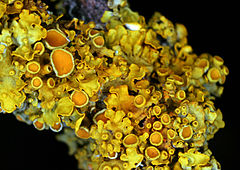Xanthoria parietina
| Xanthoria parietina | |
|---|---|
 |
|
| Scientific classification | |
| Kingdom: | Fungi |
| Division: | Ascomycota |
| Class: | Lecanoromycetes |
| Order: | Teloschistales |
| Family: | Teloschistaceae |
| Genus: | Xanthoria |
| Species: | X. parietina |
| Binomial name | |
|
Xanthoria parietina (L.) Th. Fr. (1860) |
|
Xanthoria parietina is a foliose, or leafy, lichen. It has wide distribution, and many common names such as common orange lichen, yellow scale, maritime sunburst lichen and shore lichen. It can be found near the shore on rocks or walls (hence the epithet parietina meaning "on walls"), and also on inland rocks, walls, or tree bark. It was chosen as a model organism for genomic sequencing (planned in 2006) by the US Department of Energy Joint Genome Institute (JGI). In the past it was used as a remedy for jaundice because of its yellow color.
The species was first described by Carl Linnaeus in 1753, as Lichen parietinus.
The vegetative body of the lichen, the thallus, is foliose, and typically less than 8 centimetres (3.1 in) wide. The lobes of the thallus are 1–4 mm in diameter, and flattened down. The upper surface is some shade of yellow, orange, or greenish yellow, while the lower surface is white, with a cortex, and with sparse pale rhizines or hapters. The vegetative reproductive structures soredia and isidia are absent in this species, however, apothecia are usually present.
The outer "skin" of the lichen, the cortex, is composed of closely packed fungal hyphae and serves to protect the thallus from water loss due to evaporation as well as harmful effects of high levels of irradiation. In Xanthoria parietina, the thickness of the thalli is known to vary depending on the habitat in which it grows. Thalli are much thinner in shady locations than in those exposed to full sunshine; this has the effect of protecting the algae that cannot tolerate high light intensities. The lichen pigment parietin gives this species a deep yellow or orange-red color.
X. parietina prefers growing on bark and wood; it is found more rarely on rock. Nutrient enrichment by bird droppings enhances the ability of X. parietinato grow on rock.
...
Wikipedia
